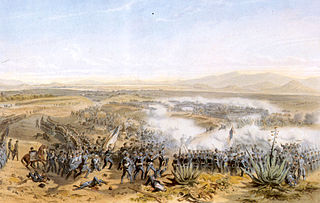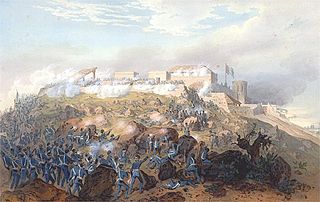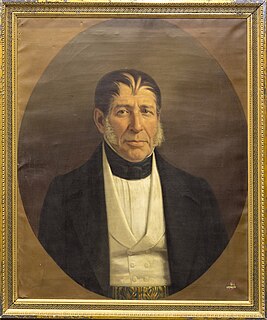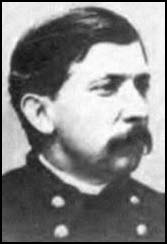Biography
Torrejón was born in Llanos de Apan in the Viceroyalty of New Spain, becoming a cadet lieutenant at the age of 14. He fought on the Royalist side during the Mexican War of Independence and by the early 1820s had been promoted to the rank of Lieutenant-Colonel. In 1823, with New Spain now ruled by the Mexican Empire of Agustín de Iturbide, Torrejón backed Antonio López de Santa Anna's Plan of Casa Mata that made Mexico a republic and as a Brigadier General in 1845 overthrew Jose Joaquin de Herrera's government in favor of Mariano Paredes y Arrillaga.
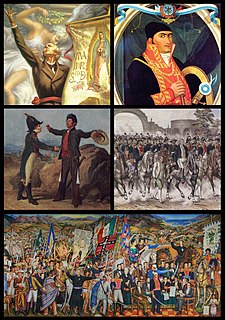
The Mexican War of Independence was an armed conflict, and the culmination of a political and social process which ended the rule of Spain in 1821 in the territory of New Spain. The war had its antecedent in Napoleon's French invasion of Spain in 1808; it extended from the Cry of Dolores by Father Miguel Hidalgo y Costilla on September 16, 1810, to the entrance of the Army of the Three Guarantees led by Agustín de Iturbide to Mexico City on September 27, 1821. September 16 is celebrated as Mexican Independence Day.

The Mexican Empire was a short-lived monarchy, and the first independent post-colonial imperial state in Mexico. It was the only former colony of the Spanish Empire to establish a monarchy after independence. Together with the Brazilian Empire, it was one of two European-style empires in the Americas. The Mexican Empire lasted two years.

Agustín de Iturbide, in full Agustín Cosme Damián de Iturbide y Arámburu, also known as Augustine of Mexico, was a Mexican army general and politician. During the Mexican War of Independence, he built a successful political and military coalition that took control in Mexico City on 27 September 1821, decisively gaining independence for Mexico. After the secession of Mexico was secured, he was proclaimed President of the Regency in 1821. A year later, he was announced as the Constitutional Emperor of Mexico, reigning briefly from 19 May 1822 to 19 March 1823. He is credited as the original designer of the first Mexican flag.
On the eve of the outbreak of hostilities with the United States, Torrejón commanded the 3rd Cavalry Brigade of Brigadier-General Mariano Arista's Army of the North, and on 24 April 1846 he forded the Río Bravo del Norte during the Mexican-American War. At Rancho Carricitos he attacked Captain Seth Thornton's two companies of American dragoons and defeated them in the "Thornton Affair", the start of the war between the U.S. and Mexico. His attempt to block the Point Isabel Road and to attack General Zachary Taylor's supply trains failed and in the 1847 Battle of Buena Vista his cavalry nearly drove the Americans back, but in doing so placed them in front of the American artillery. Torrejón participated in the battles for Mexico City soon after, covering the retreat of the Mexican army to defend the capital in the Battle of Contreras. He later engaged the Americans at San Cosme Gate.

The United States of America (USA), commonly known as the United States or America, is a country composed of 50 states, a federal district, five major self-governing territories, and various possessions. At 3.8 million square miles, the United States is the world's third or fourth largest country by total area and is slightly smaller than the entire continent of Europe's 3.9 million square miles. With a population of over 327 million people, the U.S. is the third most populous country. The capital is Washington, D.C., and the largest city by population is New York City. Forty-eight states and the capital's federal district are contiguous in North America between Canada and Mexico. The State of Alaska is in the northwest corner of North America, bordered by Canada to the east and across the Bering Strait from Russia to the west. The State of Hawaii is an archipelago in the mid-Pacific Ocean. The U.S. territories are scattered about the Pacific Ocean and the Caribbean Sea, stretching across nine official time zones. The extremely diverse geography, climate, and wildlife of the United States make it one of the world's 17 megadiverse countries.
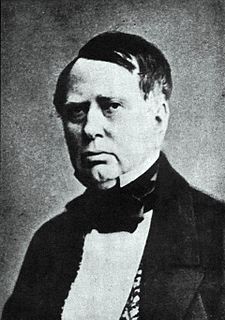
José Mariano Martín Buenaventura Ignacio Nepomuceno García de Arista Nuez was a noted veteran of many of Mexico's nineteenth-century wars. He served as president of Mexico from 15 January 1851 to 6 January 1853.

The Thornton Affair, also known as the Thornton Skirmish, Thornton's Defeat, or Rancho Carricitos was a battle in 1846 between the military forces of the United States and Mexico twenty miles west upriver from Zachary Taylor's camp along the Rio Grande. The much larger Mexican force defeated the Americans in the opening of hostilities, and was the primary justification for U.S. President James K. Polk's call to Congress to declare war.
After the Mexican-American War, Torrejón became the commanding general at Michoacán in 1854, and he died around 1861.





